You walk into the famous Woolworth’s display of 1952 Topps cards for sale. Do you pick up a pack of Topps? Or do your eyes wonder to the other dozen offerings with pictures of your favorite player? Are there even cards of your favorite team in the packs you are looking at?
It may have seemed like Topps had every baseball need met after flooding retail shelves with its new “giant size” cards. At the time it was the largest set ever issued in baseball card history, excluding the problematic cataloging of multiple issues into the T-206 set of 1909-12. Topps not only provided more than 400 different players, 151 of them were only available via the gum manufacturer’s offering. 28 Members of the checklist would go on to have plaques on display in Cooperstown with 5 Hall of Famers (Ed Mathews, Hoyt Wilhem, Billy Herman, Dick Williams, and Bill Dickey) available solely via Topps.
Hindsight makes these cards stand out above the rest, but was it all so clear 72 years ago? What exactly where the other often more established brands offering?
Bowman
The reigning market leader at the time was Bowman. It’s 252-card offering was physically smaller than modern cards at just a touch over 2×3, giving them half the surface area of Topps’ “size matters” approach to the hobby. Like the upstart Topps, Bowman employed a facsimile autograph on the front of its cards. Continuing a multiyear tradition, the card manufacturer commissioned vivid artwork to adorn the fronts rather than Flexichrome colorized photographs. Frankly, the poses selected for Bowman cards are better than most of the ones used by Topps. Further differentiating the set from its rival’s product, part of Bowman backs are taken up by advertising for a promotional baseball cap giveaway.

Despite extensive use of exclusive agreements with the players underpinning each checklist, almost 90% of Bowman’s offering overlaps with the Topps checklist. Of the 30 Bowman players omitted by Topps, 20 are unique to the Bowman set for the year and do not appear in any competing offering. While 11% of the overall checklist is in the Hall of Fame, none of these entirely unique names are among them. Bowman found two additional Hall of Famers beyond what Topps offered, but they were both managers (Casey Stengel and Bucky Harris). 42 rookie cards were possible in Bowman packs, with each of the key names captured by Bowman (Minnie Minoso, Gil McDougald, Bob Friend) also present in the Topps checklist. Key veterans captured by Bowman and missed by Topps include Stan Musial, Ralph Kiner, and Nellie Fox.
Part of Topps’ allure is the presence of a very difficult 97-card series released at the end of the season. While rarely getting the same level of collector attention, Bowman’s 1952 release also features a challenging group of high numbered cards. Topps famously saved Mickey Mantle for its capstone series and Bowman answered with Willie Mays in its own high series.
Wheaties
Sometimes you didn’t need to buy packs of baseball cards in order to build out a collection. Cards could be the packaging of other goods. Wheaties has been connected with sports for nearly a century owing to the products use of athletic imagery and constant advertising alongside sporting events. Boxes of the cereal featured baseball cards on the back as early as the 1930s, capturing the likenesses of Lou Gehrig, Joe DiMaggio, and Jimmie Foxx. The practice was discontinued at the end of 1952, giving active collectors of that period one more alternative to Topps at the checkout counter.
That year, Wheaties continued its usual white, orange, and blue color scheme with cards printed directly on the back and side panel of cereal boxes. Combined, these panels contain a selection of 10 out 60 cards in the checklist. The cards are slightly smaller than the ’52 Bowman issue and must be hand cut from cereal boxes. There are no visual aids as to where the cards end and the rest of the packaging begins, leaving collectors with cards of all sizes and varying amounts (if any) of blue outlines along the white borders.
The set features 30 athletes from multiple sports with each displaying a portrait and action image varieties. A full third of the checklist is taken up by baseball names, all of which were widely recognized high performing players. There are no slouches in this group, which includes Stan Musial and Ted Williams, both of which are missing from Topps. In total, 7 of the 10 baseball players in the checklist are present in ’52 Topps. It’s a set heavy with star power, as 9 of 10 are in the Hall of Fame.
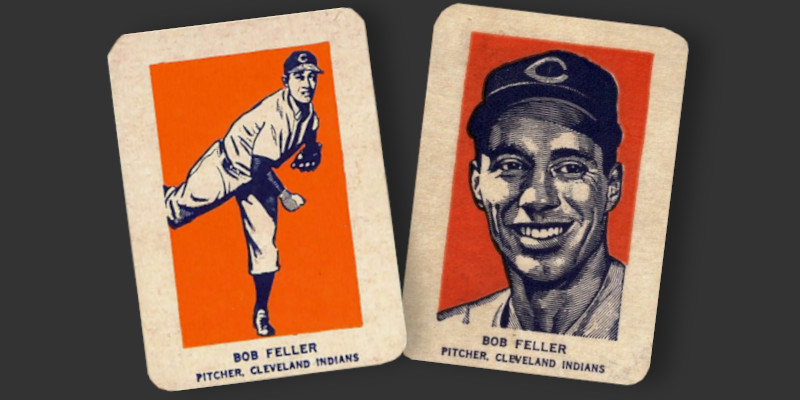
Some buyers of Wheaties got even more baseball with their cards, as the cereal maker glued small tin trays to select boxes. These trays were just large enough to support a bowl of cereal and featured a color photograph and facsimile signature of one of four baseball players. While three of the names (Musial, Kiner, and Rizzuto) are already part of the regular Wheaties set, Jackie Robinson makes an appearance as part this card-adjacent issue.
Num Num Indians
It’s hard to believe, but Topps did not have the largest baseball cards of the year. Packages of regional potato chip brand Num Num came with gigantic baseball cards, reviving a promotion that had previously been seen two years earlier. The oversized collectibles, roughly the size of a large index card, feature black and white photographs of 20 members of the Cleveland Indians. The player name appears on a detachable tab at the bottom. Collectors who assembled the entire team set could exchange the tabs for an autographed baseball from the Cleveland player of their choice. With such an offer on the table, finding intact copies is a challenge.
Topps and Num Num both had the Cleveland Indians pretty well covered in 1952. Topps did not include a card of Al Lopez in its checklist while he appears in the potato chip issue. Interestingly, both Topps and Num Num included players’ eye color on the back. Num Num took it several steps further, mentioning ancestry and marital status. That’s right ladies, you could buy a bag of chips and discover if the Anglo-Greek “Chic” Chakales is available.

In addition to the overly informative set issued by Num Num, Cleveland fans could land similar looking photocards with the black and white images directly from the Cleveland Indians. Team issued cards did not include an autograph offer or have any information printed on the back, but did add player names in a script reminiscent of a signature.
Coca Cola
Gum. Cereal. Chips. Pretty soon collectors could find themselves getting thirsty. Coca-Cola had them covered with a 10 card set that came attached to six-packs of bottled drinks in the New York area. Befitting such a regional issue, all 9 players (playoff hero Bobby Thomson is pictured twice) are either Giants, Yankees, or Dodgers. Brooklyn outfielder Carl Furillo is the only name not appearing in the Topps checklist.

These oversized cards are fairly tough to come by and come in an odd shape that makes high grade examples nearly impossible. Making the issue even more challenging is the presence of two additional cards (Willie Mays and Phil Rizzuto) only made available in as a test prior to the mass production of the primary checklist. The Mays very well may be the most difficult card to track down of his 7 different 1952 issues. The test issues note that there are 11 cards in the checklist while the final product states only 10 would be available.
Coca-Cola’s corporate archives has at least one of the Mays test cards and has publicly displayed it in exhibitions of the firm’s advertising history. Mays himself would go on to become a spokesman for Coke’s Tab brand in the 1970s.
Red Man Double-Header
Tobacco cards were not only produced at the turn of the century. The familiar “T-card” designation returned in 1952 with the T-232 set from Red Man Tobacco. Red Man is the former brand name of America’s Best Chew” chewing tobacco and had its distribution network primarily focused on the midwest when these cards were introduced. Not having to conform to the small cigarette boxes of 50 years earlier, these tobacco cards measure nearly 4″ square. A small portion of the cards were designed to be separated and used as part of a mail order promotion, rendering fully intact cards more desirable and harder to find. The tabs include expiration dates in March and June, indicating distribution took place very early in the year.
The set represents a pair of fantasy teams with rosters selected by Sporting News editor J.G. Taylor and headed by the managers of the teams appearing in the 1951 World Series. Featuring some of the most popular players of the era (21 Hall of Famers!), no part of the checklist is completely unique to the issuer. All but 7 of the 52 cards overlap with the Topps checklist, the most notable of these being Stan Musial and Ted Williams. Willie Mays is the key card in the set and the checklist even features a Minnie Minoso rookie.

Hit Parade of Champions
I hate these so much. For starters, they lie to you and do so in the way a con artist would. When reading the back of one of these knock-off cards you are immediately hit with the set’s brand name IN ALL CAPS. Fine. Par for the course (“Topps Baseball” is written the same way in 1952) and an acceptable design element. The next bit of text isn’t the player name or a fun fact, but rather a notice of the legal protections the brand owner has put in place.

The absurdity of the prominent legal notice is that these cards were unlicensed and issued without any regard for player contracts and the legal rights of others. Topps engaged in quite a bit of questionable legal maneuvering to secure players for its 1952 checklist, but the maker of Hit Parade of Champions just did away with asking in the first place. Then they had the nerve to tell you not to copy their cards.
The cards were sold in with popcorn and gum in the New York area, hopefully not to be consumed in the same mouthful, and possibly in standalone packages. Several New York players noticed the sales and brought suit against the manufacturer. The players, represented by a “friendly” Bowman-affiliated attorney, won their case and successfully shut down any further cards from this source.
The cards are often referred to as “Berk Ross” cards given that name appears in the copyright line of the series’ debut 1951 strip-card issue. Berk Ross is thought to have been a photographer rather than the maker of the cards themselves, which appear to have originated from NYC-area businessman Harry Horowitz. Ross provided Bowman with some of the images used in its baseball cards. The overlap in images between Bowman and Hit Parade products lends some credence to this theory, though it should be noted that works of other photographers such as Bob Olen (1951 Bowman/1952 Hit Parade Mickey Mantle) were the source of some images. Notably the copyright line that had accompanied the 1951 edition completely disappeared with the introduction ’52s.
59 of the 71 names in the checklist overlap with Topps in 1952 with many cards such as the Del Ennis above sharing the same image. Three of the remaining 13 cards are completely unique to Hit Parade in 1952, including the only cards issued that year for Joe DiMaggio and Bobby Doerr. Other players appearing in the checklist but omitted from Topps include Ted Williams and Stan Musial with his Bowman-exclusive contract.
Royal Desserts
Collectors had two different issues to collect in 1952 from Royal Desserts. The brand was part of the Standard Brands empire and was the chief rival of General Foods’ Jell-O brand. Seeking to boost sales, Royal Desserts incorporated baseball cards as part of its boxed packaging. The cards first appeared in 1950 and were issued for a three year period. 1952 was the final year in which Royal Desserts issued cards, though Jell-O apparently thought enough of the promotion to produce its own cards a decade later.
The cards are typically cataloged by collectors as a 1950 issue, though the manufacturer kept updating teams and stats as the years progressed. While none of the widely published price guides have collated a complete checklist of the set, a very good effort to catalog the issue has long been underway on Net54. The most interesting discovery from this thread is the fact that the often-traded Dick Sisler has 5 different cards in the set, 2 of which feature him in his 11-game stint as a St. Louis Cardinal. Fantastic stuff.
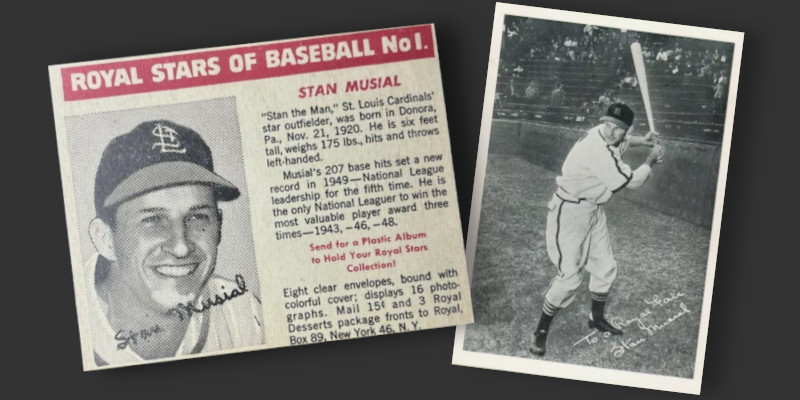
This handcut set nominally has 24 cards, but numerous variations in biographical texts, the presence/lack of advertising on the back, and assorted ink colors produce a much more difficult master checklist to chase. Most cards encountered by collectors will feature black & white imagery, though there exists a much tougher version printed with blue ink. Who says parallels are only a phenomenon in modern cards?
Most of the checklist consists of stars of the day with 19 of the names overlapping with Topps. 8 of the 24 cards in the checklist feature Hall of Famers, with Tommy Henrich and Luke Appling making possibly their sole appearance in a 1952 issue. Both made their exits from the MLB stage in 1950, so it their cards may have been omitted from the latter years of the set’s issuance. Nanny Fernandez, a decidedly non-HOF player with the Pittsburgh Pirates, is the odd man out in the set. Like Henrich and Appling, he last played in 1950. However, Fernandez had only played in parts of 4 seasons from 1941-1947 and had a longer resume in the minors at age 31 than with big league clubs. This unusual card provides the checklist with its sole unique name.
Those that purchased enough gelatin in 1952 could chase after another Royal Desserts issue: A 16-card set of black & white premiums. These giveaways consisted of a 5×7″ photo with facsimile autographs inscribed “To a royal fan.” The premium checklist includes 5 Hall of Famers, led by the ever popular Stan Musial who seemed determined to appear in pretty much every issue except Topps that year. Musial, in fact, is the only player in the premium checklist not to appear in ’52 Topps.
Tip Top Bread
More than a half dozen sets into this review and we still haven’t escaped the grocery store. Tip Top Bread had been making baseball cards since 1947 when it released a 163-name checklist that included the rookie cards of Warren Spahn and Yogi Berra. By 1952 Tip Top had improved its black & white designs a bit, giving a bright red splash and literal “star power” to the borders. The cards are an odd shape and blank backed, so the set has a bit of a what-you-see-is-what-you-get feel to it.

Like other star-centric sets of the era, the 48-card checklist is full of top flight players (11 Hall of Famers) with more than 90% overlapping with the Topps checklist. Interestingly enough, this is one of 5 sets issued in 1952 to feature Mickey Mantle.
National Tea
Amazingly Tip Top wasn’t the only firm creating cards with inverted corners. National Tea produces similar red-bordered cards with a 44-card checklist. Player selection was a little more regional with only 6 names making it to Cooperstown. While 42 names overlap with Topps, the set does have the distinction of being the only way to get a card of Danny Murtaugh in 1952, a period after he had last played for the Pittsburgh Pirates but before he would manage them to the 1960 World Series.

Central National Bank
This was about as regional an issue as one could get. These oversized, cheaply made monotone cards were given away at an Ohio based bank as part of a promotion to encourage children to open savings accounts. The 20 card checklist consists solely of Cleveland Indians, 19 of which coincide with the Topps checklist. Like Topps, these cards include a prominent team logo on the front. Cards are printed on pastel cardstock and feature players in action poses accompanied by a facsimile signature and fairly extensive statistical information. This is a very obscure issue and is rarely encountered.
Mother’s Cookies
Major League Baseball literally wasn’t the only (baseball) game in town. In fact, the sport’s most recognized league did not stretch any further west than St. Louis in 1952. Prior to the latter half of the decade those living on the west coast spent their leisure hours watching the Pacific Coast League, a top-flight minor league that existed almost on its own as an island of superb talent. Joe DiMaggio and Ted Williams both got their professional starts in California PCL ballparks. These hugely popular teams ended up having their names adopted by later expansion teams like the San Diego Padres and Los Angeles Angels.
The New York, Philadelphia, and Chicago team-heavy offerings of Topps, Bowman, and Leaf did not hold quite the same appeal to kids growing up watching the San Francisco Seals and Oakland Oaks. Mother’s Cookies, an Oakland-based grocery store staple, has a long history of inserting California-themed baseball cards into its products. The snack manufacturer included a brightly colored PCL baseball card in each bag of cookies sold in 1952.
The checklist is limited to just 64 players and managers, but carries a surprising punch for a minor league issue. Two managers, Mel Ott and Joe Gordon, are Hall of Famers. Another, Lefty O’Doul, is enshrined in the Japanese Baseball Hall of Fame. Popular Chicago Cubs’ presence Stan Hack can also be found among the managerial ranks. Chuck Conners, a former Chicago Cub, Brooklyn Dodger, and Boston Celtic (NBA) who could have easily appeared in ’52 Topps, found his way into the checklist before going on to become a television and movie actor for the next 40 years. He is perhaps the only cast member of Soylent Green who could truthfully say people pulled him from bags of food.
Being a minor league checklist, the cards frequently include the names of Major Leaguers on their way up and down the professional ranks. Bill Glynn and Bob Talbot would soon be playing in MLB ballparks on a regular basis. Johnny Lindell, Sam Chapman, Red Embree, Earl Johnson, and Al Lyons are on their way down. Snookie Welmaker didn’t get a chance to take on any of the 16-team MLB rosters, but had played in the Negro Leagues since the early 1930s and was a very good pitcher with the popular Homestead Grays. Tookie Gilbert and Jim Russell both had MLB careers and are the two names that could be pulled from either Mother’s Cookies or Topps bubble gum in 1952.
These cards are simply beautiful. I would have loved for a Major League set to have been issued using this design. The colors are unlike anything else issued that year. Corners have a distinctive “clipped” appearance, something that kids of the era appeared to apply with some regularity to their more pointy rectangular baseball cards. There aren’t any statistics to speak of on the back, which focuses primarily on advertising. The one recurring bit of data on each card is the number of years a player has been with his current team.
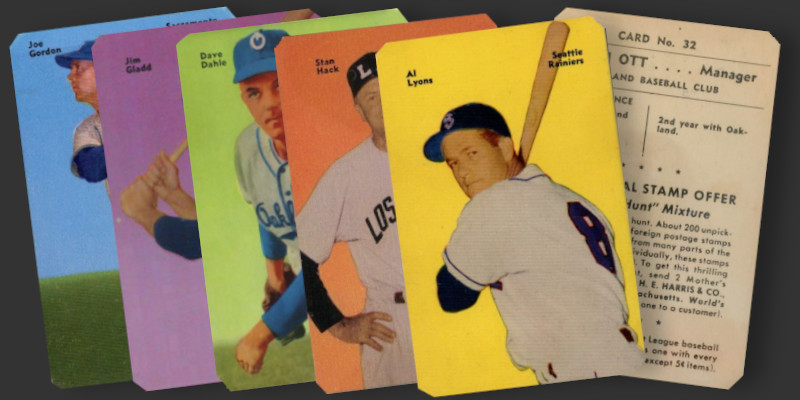
Parkhurst Frostade
Minor league issues were not limited solely to the west coast. Eastern Canada had a thriving baseball fanbase with a significant presence from high level outposts of American MLB teams. Three of these clubs were featured in an early set of small, black-and-white cards from famed hockey card producer Parkhurst. The set’s 100-card checklist consists of heavy dose of Montreal Royals (Brooklyn Dodgers), Toronto Maple Leafs (St. Louis Browns), and Ottawa Athletics (Philadelphia A’s), as well as a handful of generic baseball trivia cards. The photos actually have a good selection of poses with plenty of old ballpark infrastructure visible in most shots.
The cards were produced as inserts with packets of Frostade, a powdered drink mix akin to Kool-Aid. The back of the cards are printed in red ink with a large “Hey Kids!” banner inviting them to send a quarter and two wrappers to a guy named “Mr. Butch.” In exchange they would receive a toy gun. Bwahahahahahaha!
As a minor league issue these cards promise to include a few names that would go on to stick with their parent clubs. Charlie Bishop, a personal favorite of mine, was called up the A’s in late 1952 and would play until 1955. Brooklyn Dodgers fans will be quick to recognize early cards of Jim Gilliam and Johnny Podres, along with future managers Walt Alston and Tommy Lasorda. Rocky Nelson appears as a member of the Montreal Royals in this set and as a Brooklyn Dodger in the Topps high numbers. Bob Wellman appeared in ’52 Topps as a member of the Philadelphia Athletics, though he had been with Ottawa for the past several seasons and was more accurately portrayed in the Frostade set.
A particularly interesting name in the checklist is Dan Bankhead, one of the five black players to integrate previously all-white lineups in 1947. Bankhead had been sent back down the minor leagues after the 1950 season and was still trying to make his way back up when he was captured on this International League issue. Bankhead’s only mainstream baseball card is his 1951 Bowman rookie card and this set represents his only other English-language cardboard appearance.
The cards are devoid of much personal information beyond player names, birthdate, position, and team affiliation. However, some cards include height and weight. All cards feature card numbers in the upper left along with the brand name “Parkies” to reference Parkhurst. Hockey collectors will instantly recognize Parkies as the brand name under which the firm produced the 1951 Gordie Howe rookie – essentially that sport’s equivalent of the ’52 Topps Mickey Mantle.

Topps Look ‘N See
Baseball options were extremely limited in packs of Look ‘N See, an almost entirely non-sport offering from Topps. In fact, there was only one baseball player hiding under the wax paper packaging: Babe Ruth. Ruth was one of 135 possible cards to be found in this two-series issue. Cards feature paintings of famous historical figures, going back thousands of years for some names. Those opening packs could find names from antiquity, such as Julius Caesar or Cleopatra, mixing with living persons such as Albert Einstein and Harry Truman.
While the cards are smaller than Topps’ 1952 baseball issue and slightly smaller than modern cards, they do have some similarities with that year’s baseball offering. Subjects’ names are written in black letters in a yellow bordered name box at the bottom. A “team” logo appears at the corner of the box, indicating if the person portrayed is a notable American, military leader, or famous woman.
An orange background on the reverse makes the cards extremely condition sensitive, but facilitates the “look ‘n see” capability that gives the set its name. Cards were distributed alongside a red piece of cellophane. When held up the viewer’s eye, the red film has the effect of removing the orange background and revealing a hidden image related to the card’s subject.
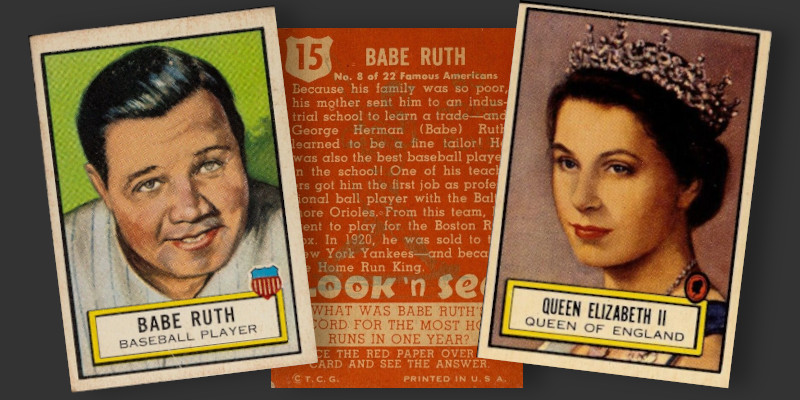
The set’s Queen Elizabeth card is notable as it can be considered her “rookie card,” or at least as far as that goes with the British. She inherited the throne on February 6 of that year.
Other Card Adjacent Offerings
The definition of what constitutes a baseball card is surprisingly hard to pin down. I made the arbitrary decision to exclude several additional offerings with varying degrees of collector interest.
Perhaps the most popular of these is a sticker set issued under the brand name Star-Cal. Originating in the Chicago area, the decals and were designed to become adhesive with the addition of warm water. They were packaged in bright red holders with an opening allowing the decal to be viewed within the sealed pack. A complete set is comprised of 100 decals, though the checklist begins repeating names after cycling through 60 players. The repeating entries appear as dual-player items comprised of a pair of scaled down miniature versions of lower numbered cards. Nearly two dozen Hall of Famers appear in the set, which even includes a ’52 Mantle for collectors to chase. The firm certainly hit the jackpot with player selection, including Willie Mays, Jackie Robinson, Ted Williams, and Stan Musial all in the same set. There are even a pair of Minnie Minoso rookies. A higher price point ($0.10 – $0.15) than Topps ($0.01 – $0.05/pack) may have influenced a preference for Topps’ gum-infused cards.
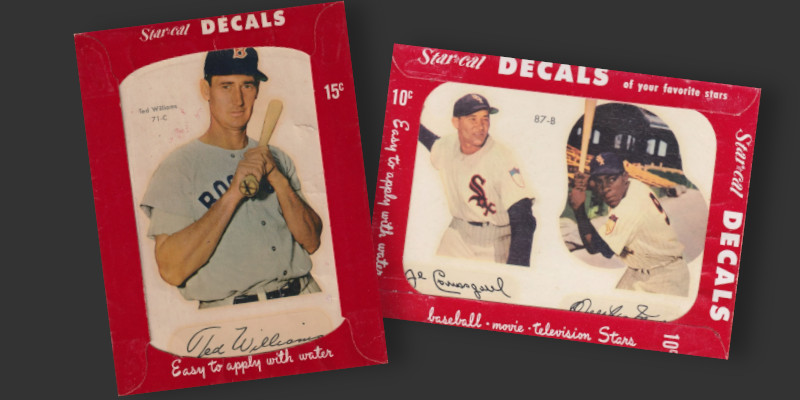
Star-Cal also pointedly did not come with any sort of edible treat. A pair of alternatives for those seeking a combination of baseball and sugar was available through the purchase of cups of Ice Cream packaged by the Dixie Cup Company. Multiple brands utilized Dixie’s services to pack and market their product. Three ounce cups were topped with a cardboard lid bearing the brand-specific logo and flavor information. Once opened, ice cream afficionados were greeted on the underside of the lid with a circular portrait of a baseball player, actor, or other pop culture celebrity. Many of the baseball photos utilize the same images as those appearing in ’52 Topps, indicating the same licensing bureau was the source for both sets. Of the 24 baseball names in the Dixie checklist, 22 appear simultaneously in the Topps set.

The lids include an offer for collectors who gathered up at least a dozen of any particular player. Those that did so could exchange the lids for an 8×10″ glossy photo of the same player.
Of course, ice cream lids did not leave much real estate for detailed player information. Even Topps’ “giant-size” cards could squeeze in only a few lines of text and two rows of statistical data. Those seeking a closer look at their player of choice could head to their nearest record store and pick up some 45 RPM vinyl from Columbia Records. The company produced a series of 8 biographical sketches of current baseball stars, enclosing each in a player-specific protective jacket loaded with photographs and line drawings associated with the athlete.




